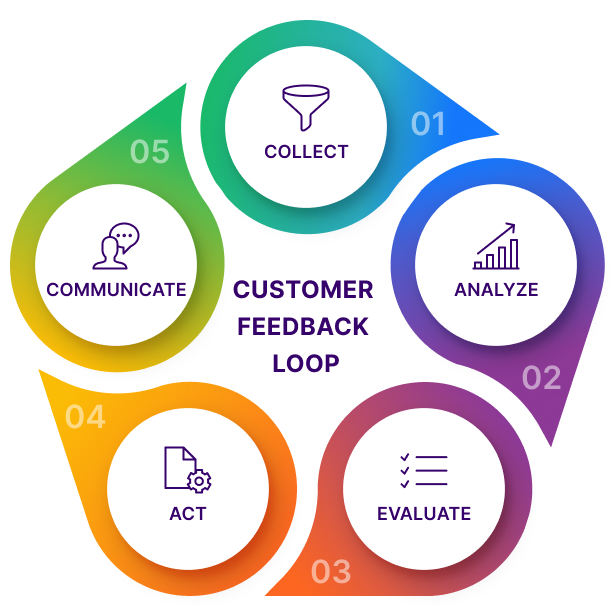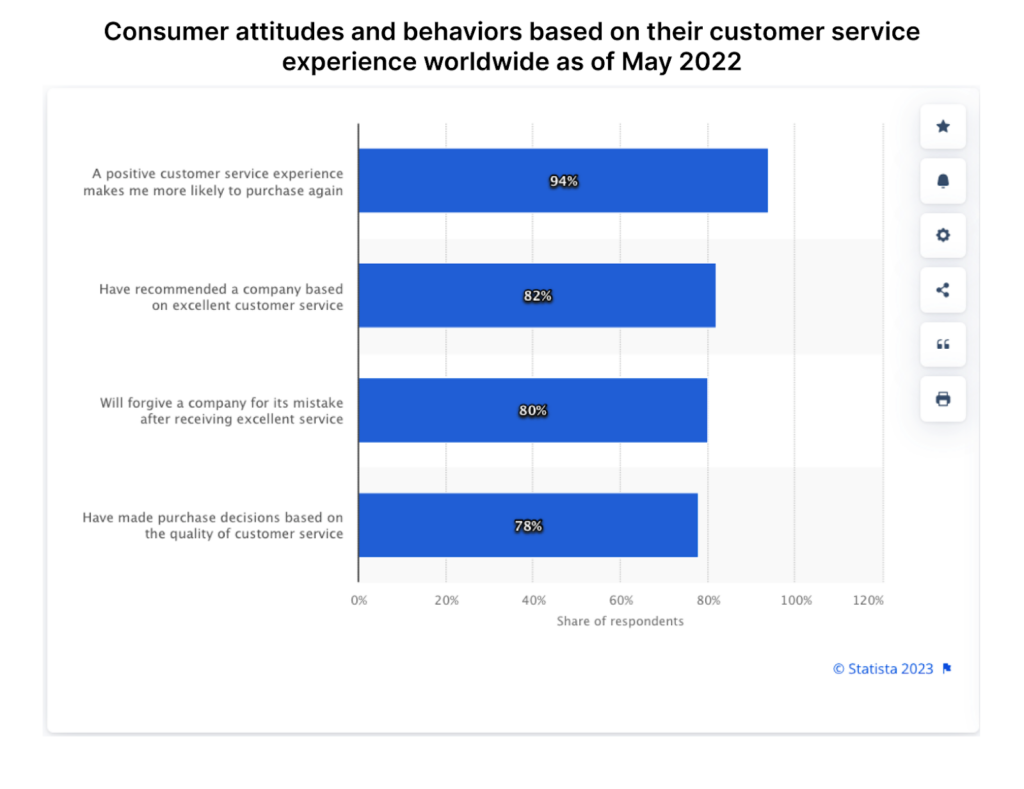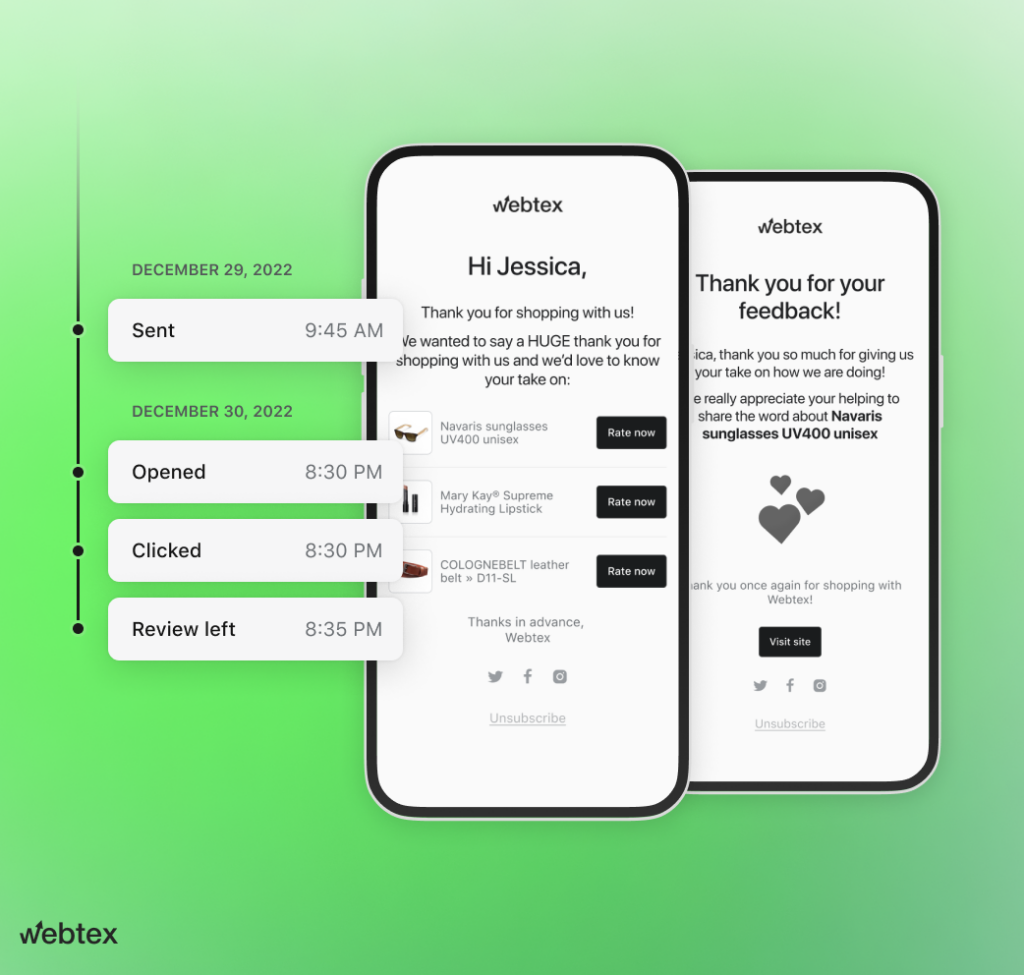In today’s fiercely competitive business landscape, customer feedback has become more critical than ever.
To truly understand the needs, preferences, and pain points of your target audience, it is essential to establish a robust and effective customer feedback loop.
By actively seeking and incorporating customer input into your business strategies — both positive and negative feedback mechanisms — you can forge stronger connections, drive product and service improvements, and ultimately, achieve greater success.
In this article, we will explore the key elements of building a customer feedback loop that not only captures valuable insights but also fosters meaningful engagement and cultivates customer loyalty. From gathering reviews to analyzing data and implementing changes, let’s embark on a journey to create a customer feedback loop that empowers your business to thrive in the modern marketplace.
So this begs the question:
Table of Contents
What is a customer feedback loop?
A customer feedback loop refers to the process of actively collecting, analyzing and utilizing feedback from customers in order to improve products, services, and overall customer experience.
It involves creating channels for customers to provide their take, collecting their opinions and suggestions, and taking appropriate actions based on that feedback.
Reasons to establish a customer feedback loop
Companies that truly understand their customers’ needs, preferences, and pain points gain a significant advantage.
To achieve this level of customer understanding, businesses must embrace the power of reviews.
Building a robust customer feedback loop is no longer a luxury; it has become an essential practice for companies aiming to thrive in the ever-evolving marketplace.
What transformative impact can a customer feedback loop have on marketing strategies and business outcomes?
Understanding customer needs
A customer feedback loop allows for a direct line of communication between companies and their customers.
It enables businesses to gain deeper insights into the needs, desires, and expectations of their target audience.
By actively soliciting and listening to customer opinions, companies can uncover valuable information about their products, services, and overall customer experience.
This understanding empowers companies to align their marketing strategies with customer needs, resulting in more targeted campaigns, improved messaging, and increased customer engagement.
Identifying areas for improvement
No company is perfect, and there is always room for improvement.
By creating a customer feedback loop, companies gain access to a wealth of information about areas that require attention and refinement.
Feedback serves as a compass, guiding companies toward addressing pain points, resolving issues, and enhancing the customer and brand experience.
It provides invaluable data that helps identify bottlenecks in the sales funnel, usability hurdles, or gaps in product offerings.
Armed with this knowledge, companies can make data-driven decisions, optimize their operations, and stay ahead of the competition.

Fostering customer loyalty
Customers appreciate being heard and having their opinions valued. By actively engaging customers through a digital feedback loop, companies demonstrate that they care about their customers’ experiences and opinions.
This, in turn, fosters a sense of loyalty and connection. When customers feel valued and heard, they are more likely to develop a long-term relationship with a company, become brand advocates, and recommend the business to others.
Enhancing product development
Customers are an invaluable source of ideas and insights when it comes to product development.
By leveraging a feedback loop, businesses can tap into the collective wisdom of their customer base to generate innovative ideas, uncover unmet needs, and refine existing products or services.
Customer opinion provides real-world usage scenarios, identifies missing features, and suggests enhancements that align with customer desires. Involving customers in the product development process not only increases the likelihood of creating successful offerings but also strengthens the bond between companies and their customers.
Continuous improvement and adaptability
The business landscape is constantly evolving, and companies must adapt to stay ahead.
A customer feedback loop facilitates a culture of continuous improvement by enabling companies to gather insights, implement changes, and measure the impact.
By continuously seeking customer take, companies can proactively adapt to changing market trends, customer preferences, and emerging challenges.
This agility and responsiveness to customer needs position companies as market leaders, capable of staying ahead of the curve and delivering exceptional customer experiences.
Steps of the customer feedback loop
While the specific steps may vary depending on the organization, here is a general outline of the client feedback loop:
Step #1: Collect
Gathering reviews from customers through various channels such as surveys, interviews, online reviews, social media, or customer support interactions.
Step #2: Analyze
Examining and categorizing the feedback to identify patterns, trends, and key issues. This step involves extracting meaningful insights from the data collected.
Step #3: Evaluate
Assessing reviews based on predefined criteria or metrics. This helps prioritize feedback based on its relevance, severity, or impact on the customer experience.
Step #4: Act
Taking appropriate actions based on the analysis and evaluation. This may involve making product improvements, addressing customer concerns, modifying processes, training employees, or implementing other changes to enhance customer satisfaction.
Step #5: Communicate
Providing feedback to customers on how their input has been considered and what actions have been taken as a result. Transparent communication helps build trust and demonstrates that the company values customer opinions.
Step #6: Iterate
Repeating the process on an ongoing basis to maintain a continuous feedback loop.
Regularly collecting and acting upon customer opinions helps drive continuous improvement and enables businesses to stay responsive to evolving customer needs.

Top feedback loop examples
From optimizing products and enhancing customer experiences to empowering employees and refining marketing strategies, these examples illuminate the transformative potential of business feedback loops in driving growth and delivering exceptional outcomes.
Some examples of business feedback loops include:
- Product feedback
- Continuous improvement feedback
- Customer satisfaction feedback
- Training and development
- Website/user experience
- Business feedback
So how can you apply feedback loops in different contexts?
Here’re some examples of how you as a business can act depending on the goal your company would like to achieve while collecting opinions. We’ve sliced the feedback loop into such steps as:
- Collection
- Analysis
- Evaluation
- Action
- Communication
Product feedback loops
Product feedback loops are crucial for businesses to continuously improve their products and services based on customer input.
Let’s explore each stage of the loop in more detail.
Collection:
The first step is to gather assessments from customers or users.
This can be done through various channels, such as surveys, feedback forms, user testing sessions, customer support interactions, or online reviews.
Companies may also leverage analytics tools to collect user behavior data and identify usage patterns.
Analysis:
Once feedback is collected, it needs to be analyzed to extract valuable insights.
This involves categorizing and organizing the feedback, identifying common themes, and understanding the underlying issues or opportunities for improvement.
Both qualitative and quantitative analysis techniques can be used to derive meaningful insights from the feedback data.
Evaluation:
In this stage, the analyzed feedback is evaluated based on several factors, including the impact on the product or service, feasibility of implementation, alignment with business goals, and customer needs.
Prioritization is key at this stage, as not all testimonials can be immediately addressed. The most important and actionable feedback is identified for further action.
Action:
Once reviews are evaluated and prioritized, appropriate actions are taken to address the identified areas for improvement.
This can involve making design changes, refining features, enhancing usability, fixing bugs, or optimizing performance.
The actions taken should align with the opinions received and aim to enhance the overall customer experience.
Communication:
Communication plays a vital role in product feedback loops.
It involves sharing the actions taken based on customer feedback with both internal teams and customers.
Internally, the feedback and actions are communicated to relevant stakeholders, such as product managers, designers, and developers.
Externally, customers should be informed about the changes implemented as a result of their feedback, reinforcing the notion that their input is valued and acted upon.

Image credit: Statista
Continuous improvement feedback loop
These feedback loops promote a culture of continuous learning and growth within organizations.
Let’s explore each stage of the loop in more detail.
Collection:
Employees are encouraged to provide feedback on processes, systems, and workplace challenges through surveys, suggestion boxes, or regular meetings.
Analysis:
Feedback is reviewed and analyzed to identify areas for improvement, bottlenecks, and opportunities.
Evaluation:
Opinions are evaluated based on impact, feasibility, and alignment with organizational goals.
Action:
Based on the results, changes are implemented, such as process modifications, training programs, or adopting new technologies.
Communication:
Updates and results of the implemented changes are communicated to employees, closing the loop and fostering a culture of continuous improvement.
Agile development feedback loop
Agile development is an iterative and incremental approach to software development that emphasizes flexibility, collaboration, and continuous improvement.
At the core of Agile development is the feedback loop, which plays a vital role in ensuring the success of the project.
Collection:
Developers receive feedback from users, stakeholders, and testers through sprint reviews, user testing sessions, and feedback channels.
Analysis:
Opinions are analyzed to identify software bugs, usability issues, and feature enhancements.
Evaluation:
Feedback is evaluated based on user needs, impact on product quality, and alignment with project goals.
Action:
Developers make changes to the software, addressing reported bugs, improving user experience, and implementing requested features.
Communication:
Updates and new releases are communicated to users and stakeholders, inviting further reviews and completing the feedback loop for the next iteration.
Customer satisfaction feedback loop
Customer feedback loops are a critical component of customer-centric businesses, as it helps them understand and meet customer expectations.
Let’s explore each stage of the loop in more detail.
Collection:
Businesses collect customer feedback through surveys, online reviews, and customer support interactions.
Analysis:
Opinions are analyzed to identify customer pain points, satisfaction levels, and trends.
Evaluation:
Opinions are evaluated based on satisfaction ratings, sentiment analysis, and customer loyalty metrics.
Action:
Companies take action to address customer concerns, improve products or services, and enhance the overall customer experience.
Communication:
Brands follow up with customers, inform them of actions taken, and seek further input, closing the loop and building customer trust.
Training and development feedback loop
If you are looking for the means to refine your training programs, enhance employee skills, and foster a culture of continuous improvement, don’t pass this feedback loop over.
Let’s explore each stage of the loop in more detail.
Collection:
Employees provide opinions on training programs through post-training evaluations, assessments, or focus groups.
Analysis:
Opinions are analyzed to assess the effectiveness of training content, delivery methods, and trainer performance.
Evaluation:
Feedback is evaluated based on learning outcomes, skill development, and employee engagement.
Action:
Training programs are modified based on reviews, incorporating suggestions, addressing gaps, and optimizing learning experiences.
Communication:
Employees are informed about changes to training programs, provided with updates, and encouraged to provide ongoing feedback for continuous improvement.
Website/user experience feedback loop
This is a continuous process that organizations should use to gather, analyze, and act upon reviews from users regarding their website or digital platform experience.
Let’s explore each stage of the loop in more detail.
Collection:
Websites collect reviews from users through user feedback forms, website analytics, and user testing sessions.
Analysis:
Opinions and analytics data are analyzed to identify usability issues, navigation challenges, and areas for improvement.
Evaluation:
Opinions are evaluated based on user satisfaction, conversion rates, and website performance metrics.
Action:
Website design and functionality are modified to improve user experience, streamline navigation, and address reported issues.
Communication:
Users are informed about website updates, and changes made based on their opinions, and encouraged to provide further input for ongoing enhancements.
As this article bumps customer reviews up as a priority, what customer feedback examples should you help in mind and focus on?
Customer feedback examples
Let’s explore a range of customer feedback examples that illustrate the power of listening to customers and how it drives marketing success:
Testimonials and reviews
One of the most impactful forms of customer feedback is testimonials and reviews.
When customers share their positive experiences with a product or service, it serves as a powerful endorsement.
Companies can leverage these testimonials by showcasing them on their website, social media or feedback platforms, or marketing materials.
Prospective customers are more likely to trust the opinions of their peers, making testimonials an effective user-generated content marketing tool to build credibility and drive conversions.

Social media engagement
In the age of social media, customers have a powerful platform to express their opinions and engage with brands.
By monitoring social media channels, companies can gather valuable customer reviews in real-time.
Social media comments, mentions, and direct messages offer insights into customer preferences, satisfaction levels, and areas for improvement.
Engaging with customers on social media not only provides an opportunity to address concerns but also demonstrates the company’s responsiveness and commitment to customer satisfaction.
Surveys and feedback forms
Conducting customer surveys and feedback forms is a proactive approach to gathering structured opinions.
By designing surveys with targeted questions, companies can collect specific insights into customer preferences, buying behavior, and satisfaction levels.
Surveys can be conducted via email, on websites, or through customer loyalty programs.
The data collected from surveys helps companies make data-driven decisions, refine their marketing strategies, and personalize their offerings to better meet customer needs.
Net Promoter Score (NPS) surveys
The Net Promoter Score (NPS) is a widely-used metric to gauge customer loyalty and brand advocacy.
NPS surveys ask customers a simple question: “On a scale of 0-10, how likely are you to recommend our product/service to a friend or colleague?”
Based on the customer feedback responses, customers are segmented into promoters (score 9-10), passives (score 7-8), and detractors (score 0-6). NPS surveys provide a quantifiable measure of customer satisfaction and loyalty, allowing companies to track their performance over time and identify areas that require attention.

Customer support interactions
Every customer support interaction presents an opportunity for valuable opinions.
When customers reach out to the support team with inquiries or issues, their opinion offers insights into areas of improvement in the company’s products, services, or processes.
Analyzing customer support interactions helps companies identify recurring concerns, address them proactively, and refine their marketing messaging to mitigate future issues.
Additionally, positive customer support experiences can be shared as success stories to reinforce the company’s commitment to customer satisfaction.
Closing customer feedback loop using Webtex
For Shopify-based businesses, Webtex can become a tool for building a customer feedback system that has it all to collect, analyze feedback data and act upon customer reviews efficiently.
Expressly, the product review app for Shopify has it all to ensure flawless implementation of the two first steps of the feedback loop creation process — collection and analysis.
The Shopify reviews app comes with tools required to showcase testimonials on your site pages, automate the process of review collection, and analyze the results of your activities.
For more details about the capabilities of the application, please refer to the official user guide.

Conclusion
The importance of creating a customer feedback loop that works cannot be overstated.
It is a strategic investment that pays rich dividends in terms of customer satisfaction, loyalty, and business growth.
By actively seeking and listening to customer opinion, companies gain invaluable insights, identify areas for improvement, and align their strategies with customer needs.
A well-established feedback loop fosters a customer-centric culture, driving continuous improvement, innovation, and adaptability.
It empowers companies to make data-driven decisions, refine their offerings, and build lasting relationships with their customers.
As businesses navigate the ever-changing landscape, embracing a customer feedback loop that works becomes a fundamental pillar of success, propelling companies towards a bright future of customer-centric excellence.


